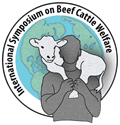Animal Welfare at Livestock Auctions
MANHATTAN, Kan. (May 20, 2010) — Animal well-being was the main focus of the
K-State Beef Cattle Institute's (BCI's) International Symposium on Beef Cattle Welfare. One area where animal care is especially visible is at auction markets, where cattle are commingled from many different producers and are constantly being moved around.
“Auction markets have gotten a bad rep,” said veterinarian Dave Sjeklocha of Haskell County Animal Hospital. “Part of that is because of the public access, really anytime, but especially on sale days. Workers are pushed to keep animals moving, there are cull/compromised animals and lots of activity with hundreds of trailers, and animals being moved four or five times per day.”

Dave Sjeklocha
Sjeklocha advised the audience to look at the Livestock Marketing Association’s (LMA's) Guide to Handling and Employee Training. The guide advises auction managers to ask questions about everything from handling and risk management issues to facility issues and when it’s time to euthanize animals.
When dealing with nonambulatory animals, Sjeklocha suggested handling with extreme caution or, preferably, not at all.
“Communicate with all producers at appreciation dinners, and explain the dangers of bringing a down animal to the market; then have a stern discussion with them if they bring them to your market,” Sjeklocha said.
He also suggests training employees to recognize when an animal is hurt and proper handling to try to avoid injury in the first place.
If an animal becomes nonambulatory in the auction market facility, a policy should be already established to prevent poor animal welfare. Humane ways to move a down animal include constructing a sling out of old baler belts, rolling the animal into a loader bucket or onto a pallet.
While the standards out there are a step in the right direction, Sjeklocha suggested things could always be better. From increasing second- or third-party audits to removing some of the objective measures involving proper electric prod usage.
The beef cattle welfare symposium was conducted on campus at K-State University May 19-21. For additional presentation summaries, return to the Meetings > Other Industry Meetings > News Coverage page of the API Virtual Library. For more about the symposium and an archive to the 2008 symposium, visit www.isbcw.beefcattleinstitute.org.
Editor's Note: LMA and BCI have collaborated to produce the Animal Care Training website www.animalcaretraining.org, offering training video, testing and certification in specific areas of livestock handling.
Editor's Note: This article was written under contract or by staff of Angus Productions Inc. (API), which claims copyright to this article. It may not be published or distributed without the express permission of API. To request reprint permission and guidelines, contact Shauna Rose Hermel, editor, at 816-383-5270.

